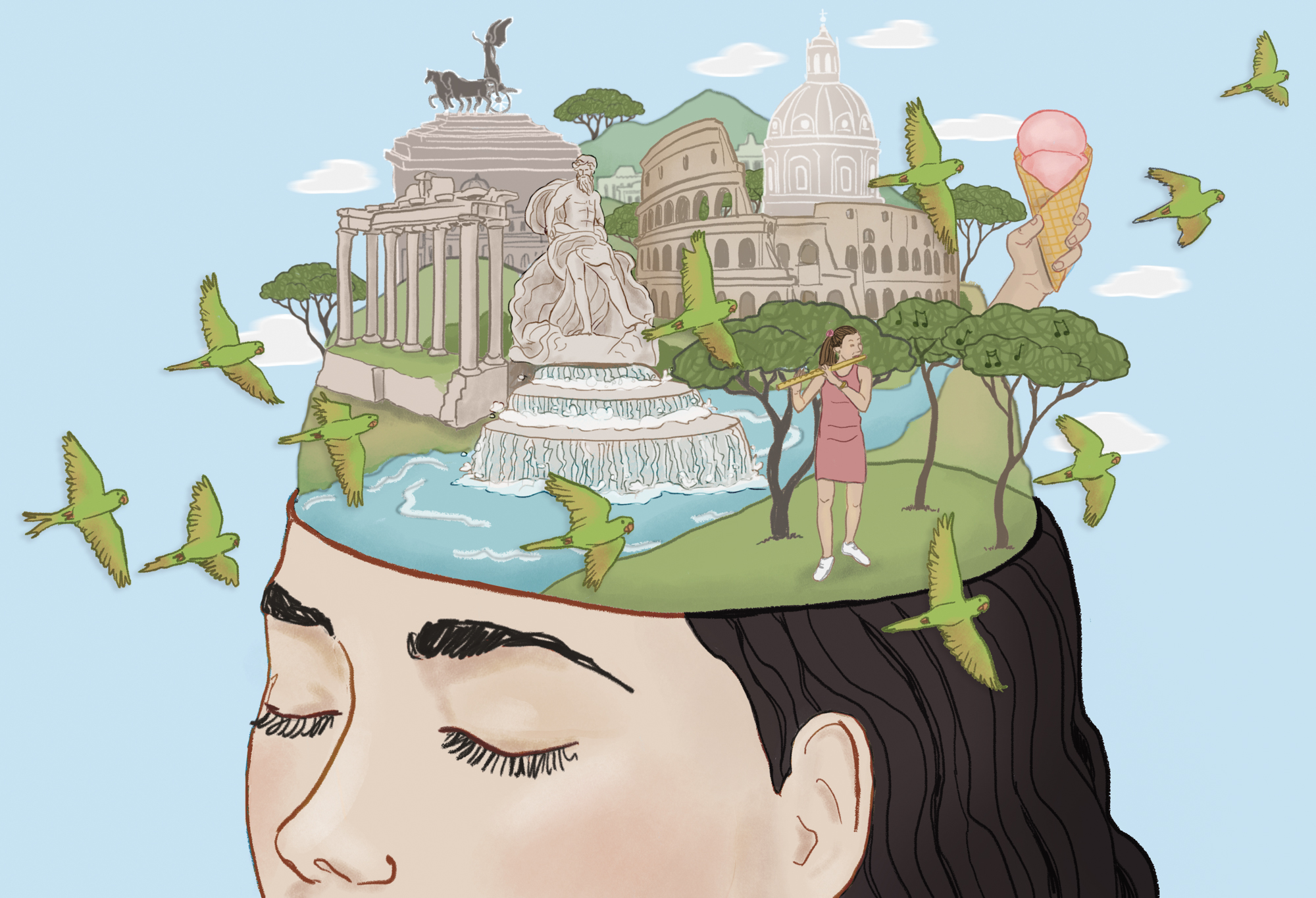Support Hidden Compass
We stand for journalism, science, history, and hope. Make a contribution to Hidden Compass and stand with us.
Curious. Whiskers vibrate as my wet nose pokes into every corner. I know this box. I’ve been here before. Hunger rumbles, but I know something delicious awaits. Where is it? I stare at the two dark bulbs and two levers before me. They’re important, somehow.
Itchy. I curl my furry black-and-white body around until my rear paw can scratch the contraption attached to my head.
There! The right bulb illuminates like a beacon — and I remember.
Go! I race to the lever on the right and press down, unaware that I’m being watched.
My reward drops into a cup. Plink. I reach with tiny paws as pleasure molecules flood my brain.
~~
Through the speakers at my lab station, I hear tiny popping, clicking sounds, much like the soft tapping of a keyboard. Deep in the heart of a rat’s brain, in an area called the striatum, electrodes have been tucked beneath wrinkly pink folds of cortex. Each pop and click represents a single brain cell — one neuron — talking to its neighbor.
Here I am, a lowly 25-year-old grad student in a windowless laboratory, enchanted. I hear each pop, click, and tap transform into instruments in a vast rat brain orchestra. Glancing at the video monitor, I see my rat friend press his lever, right on cue. I close my eyes and can literally hear him think.
The steady thrum of hunger becomes a drumbeat. Need.
Sensory input causes a sudden burst of pops like firecrackers. A trumpet fanfare rings forth. Trigger.
The entire violin section swells with the melody. Response. This is what the neurons in the striatum were waiting for, what they were born for. The striatum’s signature song reverberates across the rest of the brain, coordinating the execution of a sequence of muscle movements in response to the incoming sensory information.
A sugar pellet drops into a cup. Reward.
Endogenous opioids and cannabinoids, the brain’s pleasure molecules, bathe the brain with a piccolo’s trill, a coda that concludes the four-part orchestral song like a soft sigh of indulgence.
Need → trigger → response → reward. The building blocks of behavior. With practice, behaviors that were once flexible and adaptive become rigid and habitual. Yet habits are quite adaptive in their own way. They require less mental effort to execute and thus save energy and time.
Neuroscientists like me often say, “Neurons that fire together, wire together.” Fat cables carrying electrical impulses do in fact connect neuron to neuron in the most elaborate electrical wiring diagram ever conceived on Earth. Practice reinforces the programming until only two building blocks are needed: need → trigger → response → reward. This rat is slowly but surely switching to autopilot.
Through my speakers, I hear a habit being born.
~~
It’s 20 years later, and Florence, Italy, is a kaleidoscope of rewarding pleasure molecules. My husband and I follow the electric blue line on my phone’s map to a sprawling Florentine market painted in rainbow hues, infused with the scent of a harvest feast. My iPhone pings. On autopilot, my hand unzips a pocket in my purse. A long text. I can read it later.
My teenage son pauses at the gelateria. He’s systematically working his way through every single gelato flavor in Italy; the more unusual, the better. As his gelato slowly disappears, I rapid-fire my way through texts and emails.
My spirited nine-year old daughter races up the tilting, fun-house stairway between the inner and outer dome of the iconic Florence Cathedral, the Duomo. Emerging breathless atop the tallest building in the city, she sits beside me with wonder in her eyes as the sunset kisses the rooftops with tangerine and flamingo colors. The desire to capture the memory is a steady, urgent itch. The many panoramic photos I take can’t do the vision justice, but I start a Facebook post anyway.
The image is stored, not digitally, but in the flowing script of brain chemistry coursing from one neuron to the next.
My son interrupts with a tap on the shoulder. He points toward the rest of our family disappearing down the stairs. We race after them.
On the train, we zone out on our devices. Our brains and hearts are full, our bodies tired and craving our beds. As we near Rome, we shove our electronics into pants pockets and overstuffed backpacks. We ready ourselves to catch the subway. Just two stops to go.
We’re the perfect mark.

Illustration by Annie Davidson.
~~
A new day. I’m back in this box. This time, though, my tummy is full, and I’m a little sleepy. The drums are quiet.
Light! My head still turns.
Go! The yearning to respond is insistent. I can’t help but run and push the lever.
But wait a minute … Where’s my reward?!?
Poof. It’s gone.
~~
It’s as if I watch it all happen through a grainy, black-and-white video monitor framed by lab speakers.
The subway car is packed. Two young men crush in behind a woman and her family, blocking the door because there is nowhere else to stand. They are short, not much taller than the woman, with dark and handsome Mediterranean complexions and thick, nearly black hair. They chat softly in Italian with lilting tenor voices. They seem to be friends or cousins, out for dinner or a night on the town. One of their arms stretches over the mom’s head to grasp the bar above. The other man holds onto his friend. The woman — my research subject — yawns while staring at her phone.
As the train rumbles forward, the woman maneuvers an overstuffed backpack from her chest to her back. She slips her phone into her front pocket, and tugs her shirt down over it. She makes eye contact with her husband and two kids. They nod back.
The young man on the left asks, “Getting off here? Or at the next station?”
“Here,” the woman says.
The subway doors open. The man on the right slides past to join his friend, making room for the family to exit. He jostles the woman slightly as he steps past.
She walks onto the platform and looks about for her kids. Suddenly, she’s frantic. She scrambles at her front pocket, then her back pockets. From the speakers of my imaginary lab station, the pops and taps emanating from her brain are as loud and rapid as the finale of a fireworks show. She looks up and freezes. The speakers go silent for an instant, the eye of a hurricane. The train has just pulled away. With a swoosh of air, two dastardly thieves and a shiny red iPhone vanish into the darkness.
The speakers erupt in a cacophony of frantic brain activity. It’s impossible to make sense of it all in real time.
Minutes later, the woman bursts into an apartment, locks down her stolen phone, and spends the next few hours staring at a computer screen, watching her phone’s final geolocation pings. There it is by the Piazza del Popolo. Now, it doubles back to the train station. Its very last ping cries out from near the University of Rome. Then silence. Poof. It’s gone.
~~
In my lab, it’s experiment time: What happens if I turn dopamine off in the brain?
On my desk is a recent paper by Wolfram Schultz on which I had scrawled in the margin, “This changes everything!” Despite being pop science’s darling, dopamine is largely misunderstood. Contrary to popular belief, dopamine is not the brain’s reward molecule. Rather, it signals novelty, change, and the unexpected.
Dopamine bathes the striatum when the rat’s box is new and novel. It arrives in a burst of insight, when the rat discovers the connection between lever press and sugar. It’s there the first time the rat tastes sweet candy after a lifetime of bland food pellets. And dopamine floods the brain when a well-established habit vanishes into the dark.
Dopamine says, “Here’s something new! Pay attention.” It helps the rat learn. It helps a young neuroscientist make a discovery.
I start a micropump to precisely deliver 500 nanoliters of medication to quiet dopamine at its source. With a minuscule injection — the size of Abe Lincoln’s eyeball on a penny — I can erase dopamine from the equation and listen to the brain song change.
The violins still carry the melody, coordinating the rat’s response.
The piccolos still trill with sugary reward.
But no trumpets sound with the trigger. When the light turns on, the striatum is as quiet as midnight.
I sit up in my chair. This is big. This result, if repeatable, will earn me my PhD. I just demonstrated that dopamine’s role in the striatum is to cue the trumpets.
~~
I wake up and immediately claw at my nightstand. No phone.
My husband’s phone pings, yet it’s my hand that flies to my pocket.
My daughter and I go out to forage for lunch. When we discover that the local bakery is closed, I dig through my purse to try searching Google Maps for an alternative before a sweet nine-year-old voice cuts through the haze.
“Mom, they took your phone. Don’t you remember?”
~~
The desire to capture the memory is a steady, urgent itch.
My neuroscientist self watches my traveler self flounder in the first few days of shaky, itchy withdrawal. Before the incident, this female subject had averaged 348 phone pickups per day, equivalent to checking her phone every 2–3 waking minutes. A smartphone is so much more than a piece of technology. This subject ran her life on it. Just like 44% of adults under the age of 50 in America, she was online almost constantly. Her phone had her wired to respond.
And now her phone has been stolen. It’s gone. I can’t wait to see what might happen in this experiment. Once triggered, rats will press a lever hundreds, sometimes thousands, of times without any motivational need and without any reward at all. What will happen to her?
~~
Dopamine floods the brain with every trigger. Her habit is so ingrained that my poor research subject simply can’t resist. She doesn’t yet know another way to respond besides pawing her pocket, over and over again.
Another wave of dopamine crests when all her hand finds is lint. Again and again. She sheds tears of frustration at her own behavior. She hurls long strings of expletives toward the pickpockets. She argues with her family. Yet she still reaches for that missing phone — hundreds of times a day.
She storms across Rome to the Apple store to try to buy a new phone, only to discover that it would cost over $300 extra to replace the phone in Italy versus waiting to return home. Phones sold in Europe aren’t compatible with her American cell service anyway. She’ll have to wait.
She seethes at the prospect of being phoneless for the remaining 15,250 minutes of her European vacation: 10 days, 14 hours, 10 minutes.
Beneath the simmering annoyance and grumpiness is a deep longing — for the smooth, red contours of her companion, her external brain. The unrelenting flood of dopamine drives her, with determined footsteps, to the police station to file a report. Pity. It won’t do any good. Even she knows that.
Three blocks from her apartment, on the first floor of a nondescript beige building, is the police station. The only indication that she’s found her destination is the sign beside the door reading “Stazione Carabinieri di Roma Via Vittorio Veneto” and two teeny police cars out front.
A young officer, handsome as a magazine ad, softly guides her through the paperwork. She extracts a slip of paper on which she’s written her phone’s serial number.
She pauses. She’d never once written a serial number longhand before. The string of random letters and numbers looks like the secret code to a puzzle. She loves puzzles. Perhaps this is a puzzle she could solve. She is, after all, a neuroscientist.
~~
A friend in my lab also records the orchestral song of neurons, but he puts his rats into mazes instead of lever-pressing boxes. And instead of the striatum, he listens to a curly, seahorse-shaped brain area called the hippocampus. Without the hippocampus, you get the curious case of H.M., the most famous neurosurgery patient of all time, whose ability to remember anything for more than a few minutes vanished when his hippocampus was removed to control seizures.
While I record habits, my friend records memories.
The first time my friend introduces a rat to a maze, a specific neuronal ensemble sings a chord. That chord in the brain is a memory trace, what we scientists lovingly call an engram. Each time a rat returns to the same place in a maze, that same chord is reinforced, archiving the engram into long-term memory. When the rat moves further into the maze, the electrodes detect a different engram.
Later, after the rat falls asleep, my friend can quite literally read the rat’s dreams. He knows precisely where the rat thinks it is in its dream maze as first one recognizable chord, then another, is played.
~~
Enchanted[,] I hear each pop, click, and tap transform into instruments in a vast rat brain orchestra.
As I stare at the random string of letters and numbers, my perspective shifts. I lift out of my triggered dopamine haze and have a brief out-of-body experience. Suddenly, I’m looking down upon myself there in the stazione carabinieri. I watch myself as if the young woman below is Audrey Hepburn in Roman Holiday, a runaway princess caught in an unexpected adventure, caught in a box of her own making. I laugh out loud.
I recall a story about the philosopher Friedrich Nietzsche. In his later years, Nietzsche’s vision was failing, and writing caused crushing migraines. He got a typewriter. As he mastered touch typing, ideas could once again flow. However, friends and scholars noticed that Nietzsche’s entire writing style shifted with the new technology, becoming more rigid, staccato, and telegraphic — like the typewriter itself — compared to the fluidity of ink on paper. When a friend brought this to Nietzsche’s attention in a letter, he responded, “You are right … Our writing equipment takes part in the forming of our thoughts.”
Brains are changeable things. John M. Culkin, founder of the Center for Understanding Media, wrote, “we shape our tools and thereafter they shape us.” Indeed they do. The latest research by Christian Montag from Ulm University in Germany shows that the more often we use our smartphones, the smaller our striatum gets, with less and less dopamine synthesized and released there.
As my traveler self holds that serial number written with ink on paper, my inner neuroscientist recognizes what my phone has done to my brain over the years. I decide I’m going to reengineer my brain. Instead of a rigid, telegraphic, wired brain, with a small striatum and weakened dopamine response, what might my brain be like when written in longhand with free-flowing ink?
This period of phonelessness, I realize, is a gift — an unexpected adventure, an unplanned digital detox, an experiment. If my phone has me wired to respond, how much can I rewire it in the 15,000 minutes left of this trip?
~~
It starts with my lack of a camera.
I’m watching my daughter wave from the top of a play structure at the playground, and I realize that there are rose-ringed parakeets in the tall trees behind her. There’s that familiar itch: I want to take a video to capture the moment. But no phone.
It’s left to my eyes to capture and burn the image into my brain’s visual cortex — the blonde wood of the play structure, my daughter’s hazel eyes locked on mine, towering lollipop trees, and dozens of brilliant green parakeets flashing magenta from their wings as they soar against a blue-gray sky.
Pop, click, tap, go the neurons in my brain’s hippocampus. The image is stored, not digitally, but in the flowing script of brain chemistry coursing from one neuron to the next.
~~
A few days later, I’m in the whispering gallery of St. Peter’s Basilica, suspended, as if weightless, hundreds of feet above the cathedral floor, yet still hundreds of feet below the peak of Michelangelo’s floating dome. The opposite wall is an eternity away. The Statue of Liberty can fit beneath this dome.
My heart skips at the sheer size of it all — how infinite and soaring the space, yet how small but connected I feel to history, to engineering, to God. I see angels with trumpets frozen in marble and mosaic. I hear those trumpets call in my mind. I want — no, I crave — my phone to capture this moment.
Once triggered, rats will press a lever hundreds, sometimes thousands, of times without any motivational need and without any reward at all.
But instead, I lean into my emotions. Awe. Thrill. Delight. Ironically, years of living with a smartphone had pre-programmed trumpets to alert me to moments of magic. For this priceless moment, I stand still and feel. Wonder washes over me.
Piccolos trill, without the need for violins to move my hand to my pocket. How unexpected. Dopamine blankets my brain, and I learn. Need → trigger → a new response → reward. A neuronal ensemble plays a brand-new tune.
~~
I’m out for a walk along Rome’s twisted, winding, cobblestoned streets, and I’m not entirely sure of my way home. This time, GPS is not in my pocket to be consulted. Without the overbearing presence of an app, I discover a quiet, nascent map of Rome in my head. The Pantheon feels familiar, as an engram plays a familiar chord. Trevi Fountain sounds with a different, yet recognizable, harmony.
I hadn’t noticed the singing of these neuronal ensembles before, so dependent was I upon GPS. But now, the well-wandered paths my husband and I had explored over the previous weeks have taken on the jingle of a well-worn tune. As the music grows louder in my mind, I discover that I have traded Google Maps for a sense of place.
~~
What might my brain be like when written in longhand with free-flowing ink?
At the end of our guided tour of the Colosseum, I stand on the arena floor where blood was spilled millenia ago. I look up at the towering stonework above and then down into the brilliantly engineered underground labyrinth below. I feel the itch of dopamine triggering me. I must capture the moment. But this time, I have a new response to try. This time, I breathe in the moment in multisensory technicolor.
I spend a full minute doing a slow, 360-degree rotation. My eyes record the color of the earthy-brown stone against an expansive sky. Travertine arches reach upward all around. My brain encodes and stores those firing patterns in my visual cortex.
I let my feet shuffle against the earthen floor. The scratchy feel of the gravel beneath my feet grinds its way into my somatosensory cortex.
I close my eyes and allow my imagination to sweep me back in time. My ears hear the echoing murmur of the tourists around me as if they are a throng of Roman citizens here to watch the greatest show of their time. The silence between the sounds is the quiet of centuries in between. The sounds are stored in my auditory cortex.
I breathe in deeply. The rain-tinged scent in the air caresses my olfactory bulb. I smell sweat, dust, and time.
And I feel it. Awe. That soaring sensation of being an insignificant speck on a grand historical tapestry beyond my comprehension, yet sure in the knowledge that I am part of the fabric. Every neuron, every cell sings. I am alive. This is living. I spin around again. Slowly. A neuronal ensemble crescendos — sight, sound, sensation, smell, emotion — and leaves a permanent memory trace in my mind.
~~
My eyes flutter open and focus on my computer screen. It’s June 2023. I reread the passage I just typed and confirm that my written words capture the engram from the arena floor with the same pristine clarity as the day my hippocampus stored it several years ago. Yes, the echo sings true. But better than any digital photo or video, the memory harmonizes across every cell of my body. Today, here in my computer chair, I now carry multisensory engrams instead of snapshots.
Whereas memories from trips before that fateful day in Rome feel blurry and require a look back at my photo collection to bring into focus, memories from after are full-spectrum surround-sound, rich, and clear. When triggered by that itch to capture a magic moment, my new response is to spin in slow circles, savoring each of my five senses, naming the emotions. Later, simply by closing my eyes, I can pull out a precious record from my mental filing cabinet, gently set it upon a mental turntable and let the orchestra play. Suddenly, I’m there again.
My reverie is interrupted by a buzzing sound on my desk. My eyes flick toward my new shiny red iPhone. A text. I feel dopamine surge. My hand reaches automatically, but then hovers in midair, inches away from the siren’s song. I have a choice.
Habit interrupted.

Illustration by Annie Davidson.
Annie Davidson is a Melbourne-based freelance illustrator whose drawings feature meticulous patterns & details, atmospheric color palettes and whimsical subjects.
Dr. Irene Salter
There’s a realm called “wonder,” where science and magic coexist. It’s where Irene Salter lives, and through her exquisite storytelling, she brings you along on the adventure.
Never miss a story
Subscribe for new issue alerts.
By submitting this form, you consent to receive updates from Hidden Compass regarding new issues and other ongoing promotions such as workshop opportunities. Please refer to our Privacy Policy for more information.



